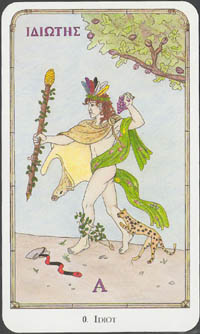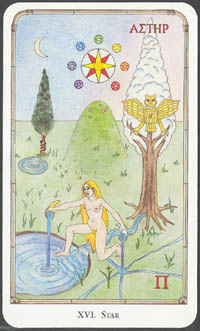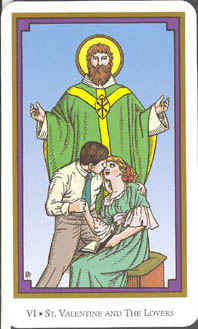|
 The American publisher, Llewellyn has over more than a century supplied the market with books on
esoteric themes, among them several books on tarot. During the later years Llewellyn has extended
its position to become one of the largest tarot sources on the American market, a position that
recently was further strengthened by a contract for distribution of tarot products from the
Italian publisher Lo Scarabeo.
The American publisher, Llewellyn has over more than a century supplied the market with books on
esoteric themes, among them several books on tarot. During the later years Llewellyn has extended
its position to become one of the largest tarot sources on the American market, a position that
recently was further strengthened by a contract for distribution of tarot products from the
Italian publisher Lo Scarabeo.
 New in Llewellyn's own range of tarot publications are John Opsopaus' "Pythagorean Tarot" and
Robert M. Place's "Tarot of the Saints". They are both substantial works, not only regarding the
contents but also physically. Both decks come with extensive books (of respectively 470 and 248 pages),
the packaging is the same in both cases, a book-size cardboard box, which contains the book and
the deck. In an attempt to solve the usual annoying problem with cards that slip around in a much
too large box, a neutral white box, which can hold any standard size tarot deck is included to keep
the deck in place. This concept will presumably be used in all forthcoming deck/book packages from
this publisher, so maybe it would be an idea if Llewellyn printed a sheet of adhesive labels,
maybe depicting one or two cards from the relevant deck, so the owner could individualize the
neutral boxes (I have already 3 of them, all looking alike but with 3 different decks in them).
Any excessive labels on the sheet might be used by the owner and serve as advertising for the deck.
New in Llewellyn's own range of tarot publications are John Opsopaus' "Pythagorean Tarot" and
Robert M. Place's "Tarot of the Saints". They are both substantial works, not only regarding the
contents but also physically. Both decks come with extensive books (of respectively 470 and 248 pages),
the packaging is the same in both cases, a book-size cardboard box, which contains the book and
the deck. In an attempt to solve the usual annoying problem with cards that slip around in a much
too large box, a neutral white box, which can hold any standard size tarot deck is included to keep
the deck in place. This concept will presumably be used in all forthcoming deck/book packages from
this publisher, so maybe it would be an idea if Llewellyn printed a sheet of adhesive labels,
maybe depicting one or two cards from the relevant deck, so the owner could individualize the
neutral boxes (I have already 3 of them, all looking alike but with 3 different decks in them).
Any excessive labels on the sheet might be used by the owner and serve as advertising for the deck.
 Opsopaus's "Pythagorean Tarot", excellently illustrated by a female artist called "Rho", is an
attempt to create a tarot deck as Pythagoras, the Greek mathematician and philosopher would have
done it, had he known about tarot. The basis for the deck's structure is numerology, which was
an important part of Pythagoras' mathematical considerations. To be able to apply the Pythagorean
numerology to the deck, Oposopaus found, that the oldest documented numbering of the major arcana,
as it was listed in "Sermones de ludo cum aliis" (ca.1500), fits the purpose well. Opsopaus discusses
this structure as well as his own assignment of Greek letters to the cards in great detail in his
book. An interesting perspective is also his pointing out the close connection of this structure to
the numbers gained by a throw of two or three dice; dice casting being one of the oldest divination
methods known.
Opsopaus's "Pythagorean Tarot", excellently illustrated by a female artist called "Rho", is an
attempt to create a tarot deck as Pythagoras, the Greek mathematician and philosopher would have
done it, had he known about tarot. The basis for the deck's structure is numerology, which was
an important part of Pythagoras' mathematical considerations. To be able to apply the Pythagorean
numerology to the deck, Oposopaus found, that the oldest documented numbering of the major arcana,
as it was listed in "Sermones de ludo cum aliis" (ca.1500), fits the purpose well. Opsopaus discusses
this structure as well as his own assignment of Greek letters to the cards in great detail in his
book. An interesting perspective is also his pointing out the close connection of this structure to
the numbers gained by a throw of two or three dice; dice casting being one of the oldest divination
methods known.
The book describes the historical, cultural, philosophical and religious backgrounds of a period,
where those ideas grew in fertile soil, which later found a visible form when tarot decks came into
being in the 16th century. Personally, I find it a lot more relevant to create a tarot deck based
upon this early Mediterranean tradition and knowledge than to adopt a lot of irrelevant mythologies
to the tarot frame, as so often is the case.
To support his text, Opsopaus makes use of many quotes from many sources, but luckily he has included
these in the text proper; is there anything more annoying than the usual academic way to have two
fingers in the back of the book while reading?
 Robert M. Place's deck "Tarot of the Saints" and his accompanying book "A Gnostic Book of Saints"
can be seen as a follow up to the Pythagorean Tarot. It takes its beginning in the same world of
ideas. Pythagoras' teachings are here also part of the background, but Place brings tarot further
up in history to Christianity. Robert M. Place's tarot is a description of the world of Saints,
whose development began during early Christianity. Each of the major arcana and court cards depict
a Saint, whose archetypal qualities correspond with the card's traditional meaning.
Robert M. Place's deck "Tarot of the Saints" and his accompanying book "A Gnostic Book of Saints"
can be seen as a follow up to the Pythagorean Tarot. It takes its beginning in the same world of
ideas. Pythagoras' teachings are here also part of the background, but Place brings tarot further
up in history to Christianity. Robert M. Place's tarot is a description of the world of Saints,
whose development began during early Christianity. Each of the major arcana and court cards depict
a Saint, whose archetypal qualities correspond with the card's traditional meaning.
 Both books are scholarly works, based upon historical facts. You will not be overrun by unsubstantial
nonsense like in so many other tarot books. You need not be a devoted tarotist to have pleasure in
reading these books and looking at the cards. An interest for the historical periods will do.
On the other hand, these two books are not for those tarot readers, who ignorantly state that they
are not interested in tarot history. For unknown reasons, the publisher's advertising material states
the target audience for "Pythagorean Tarot" as "male, 25-55 years of age". For "Tarot of the Saints"
themes like "Tarot, Santeria and Christianity" are referred to.
Both books are scholarly works, based upon historical facts. You will not be overrun by unsubstantial
nonsense like in so many other tarot books. You need not be a devoted tarotist to have pleasure in
reading these books and looking at the cards. An interest for the historical periods will do.
On the other hand, these two books are not for those tarot readers, who ignorantly state that they
are not interested in tarot history. For unknown reasons, the publisher's advertising material states
the target audience for "Pythagorean Tarot" as "male, 25-55 years of age". For "Tarot of the Saints"
themes like "Tarot, Santeria and Christianity" are referred to.
 Both decks are excellently made with high quality cardboard and printing. The art style of
"The Pythagorean Tarot" is light, simple and attractive, while Robert Place's illustrations are more
rigid with pure colors similar to stained glass paintings (as are Place's two earlier tarot decks:
"The Alchemical Tarot" and "The Angels Tarot"). While the number cards of "The Pythagorean Tarot" are
decorative, but not illustrated, Place does use vignettes, sometimes borrowing traits from the
Waite-Smith iconography. Personally, I prefer the art style of "Rho", but that is merely a matter of
taste. Place's illustrations suit very well their theme.
Both decks are excellently made with high quality cardboard and printing. The art style of
"The Pythagorean Tarot" is light, simple and attractive, while Robert Place's illustrations are more
rigid with pure colors similar to stained glass paintings (as are Place's two earlier tarot decks:
"The Alchemical Tarot" and "The Angels Tarot"). While the number cards of "The Pythagorean Tarot" are
decorative, but not illustrated, Place does use vignettes, sometimes borrowing traits from the
Waite-Smith iconography. Personally, I prefer the art style of "Rho", but that is merely a matter of
taste. Place's illustrations suit very well their theme.
If you buy these two Tarot book/deck sets and really want to explore them to their full potential,
you need not buy any other tarot packs for the next year or so. In fact they could do for the rest of
your life. Llewellyn shall be given high credit for making them available as a contrast to the endless
number of trivial packs published these days.
|